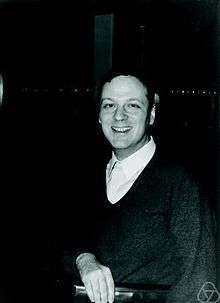Paul-André Meyer
| Paul-André Meyer | |
|---|---|
 | |
| Born |
21 August 1934 Boulogne-Billancourt |
| Died | 30 January 2003 (aged 68) |
| Nationality | French |
| Fields | Mathematics |
| Institutions | Institut de Recherche Mathématique |
| Alma mater | École Normale Supérieure |
| Doctoral advisor | Jacques Deny |
| Doctoral students |
Dominique Bakry Didier Dacunha-Castelle Catherine Doléans-Dade Michel Emery |
Paul-André Meyer (21 August 1934 – 30 January 2003) was a French mathematician, who played a major role in the development of the general theory of stochastic processes. He worked at the Institut de Recherche Mathématique (IRMA) in Strasbourg.
He is best known for his continuous-time analog of Doob's decomposition of a submartingale, known as the Doob–Meyer decomposition.
Some of his main areas of research in probability theory were the general theory of stochastic processes, Markov processes, stochastic integration, stochastic differential geometry and quantum probability. His most cited book is Probabilities and Potential B, written with Claude Dellacherie. The preceding book is the English translation of the second book in a series of five written by Meyer and Dellacherie from 1975 to 1992 and elaborated from Meyer's pioneering book Probabilités et Potentiel, published in 1966.[1][2][3]
In the period 1966-1980 Meyer organised the Seminaire de Probabilities in Strasbourg, and he and his co-workers developed what is called the general theory of processes.
This theory was concerned with the mathematical foundations of the theory of continuous time stochastic processes, especially Markov processes. Notable achievements of the 'Strasbourg School' were the development of stochastic integrals for semimartingales, and the concept of a predictable (or previsible) process.
IRMA created an annual prize in his memory; the first Paul André Meyer prize was awarded in 2004 .
Persi Diaconis of Stanford University wrote about Meyer that:[4]
I only met Paul-Andre Meyer once (at Luminy in 1995). He kindly stayed around after my talk and we spoke for about an hour. I was studying rates of convergence of finite state space Markov chains. He made it clear that, for him, finite state space Markov chains is a trivial subject. Hurt but undaunted, I explained some of our results and methods. He thought about it and said, “I see, yes, those are very hard problems”.The analytic parts of Dirichlet space theory have played an enormous role in my recent work. I am sure that there is much to learn from the abstract theory as well. In the present paper I treat rates of convergence for a simple Markov chain. I am sorry not to have another hour with Paul-Andre Meyer. Perhaps he would say “This piece of our story might help you”. Perhaps one of his students or colleagues can help fill the void.
Some books and articles written by Paul-André Meyer
- C. Dellacherie, P.A. Meyer: Probabilities and Potential B, North-Holland, Amsterdam New York 1982.
- P.A. Meyer: " Martingales and Stochastic Integrals I," Springer Lecture Notes in Mathematics 284, 1972.
- Brelot's axiomatic theory of the Dirichlet problem and Hunt's theory, Annales de l'institut Fourier, 13 no. 2 (1963), p. 357–372
- Intégrales stochastiques I, Séminaire de probabilités de Strasbourg, 1 (1967), p. 72–94
- Intégrales stochastiques II, Séminaire de probabilités de Strasbourg, 1 (1967), p. 95–117
- Intégrales stochastiques III, Séminaire de probabilités de Strasbourg, 1 (1967), p. 118–141
- Intégrales stochastiques IV, Séminaire de probabilités de Strasbourg, 1 (1967), p. 124–162
- Generation of sigma-fields by step processes, Séminaire de probabilités de Strasbourg, 10 (1976), p. 118–124
- P.A. Meyer: ' Inégalités de normes pour les integrales stochastiques," Séminaire de Probabilités XII, Springer Lecture Notes in Math. 649, 757–762, 1978.
References
- ↑ Bauer, Heinz (1968). "Review: Probabilities and potential, by P. A. Meyer". Bull. Amer. Math. Soc. 74 (1): 75–78. doi:10.1090/S0002-9904-1968-11880-4.
- ↑ Getoor, Ronald (1980). "Review: Probabilities and potential, by C. Dellacherie and P. A. Meyer". Bull. Amer. Math. Soc. (N.S.). 2 (3): 510–514. doi:10.1090/s0273-0979-1980-14787-4.
- ↑ Mitro, Joanna (1991). "Review: Probabilités et potentiel (Chapters XII – XVI), by C. Dellacherie and P. A. Meyer". Bull. Amer. Math. Soc. (N.S.). 24 (2): 471–477. doi:10.1090/s0273-0979-1991-16069-6.
- ↑ Diaconis, Persi (2005). Analysis of a Bose-Einstein Markov Chain "Analysis of a Bose–Einstein Markov chain," Check
|url=value (help) (PDF). Annales de l'Institut Henri Poincaré B. 41 (3): 409–418. doi:10.1016/j.anihpb.2004.09.007.
External links
- In memory of P. A. Meyer
- Colloque international sur les processus stochastiques et l’héritage de P.A. Meyer
- Paul-André Meyer at the Mathematics Genealogy Project
- Literature by and about Paul-André Meyer in the German National Library catalogue